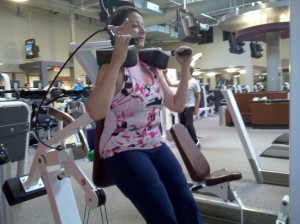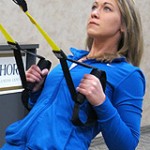by Michelle Sutton-Kerchner
Willpower isn’t reserved for those of a higher existence who exercise daily, floss often, and consider protein bars a sweet treat. Tap into yours. You may be practicing it right now …
Thoughts of willpower conjure images of resisting pizza, pumping it out on the Exercise Floor, and putting hands to the keyboard in diligent work. Yet, this trait is far more exercised than that. Willpower is a conscious determination to do what is best during any given moment. It’s the ability to resist the urge to snap at the pokey cashier who reads the legalese on coupons. It’s being able to shut off the light when tempted by another chapter in your page-turner. Heck, it’s even the decision to make your bed in anticipation of its comfort later.
Once we identify the many ways we tap into willpower in daily life, we start to recognize our own self-discipline. We become aware of the ongoing positive decisions we make in our best interest. We are no longer victims or failures of this characteristic that may let us down by the cookie jar or throw in the towel before we finish sweating it out.
All efforts require willpower, according to experts. Unless you’re performing a habitual act, even the smallest decisions represent willpower in action. Willpower is often associated with the body’s production of glucose. This sugar powers muscles, organs, and the neurotransmitters that affect brain function. As the body’s glucose levels fluctuate, so does one’s willpower. This is apparent in the “weak moment” that causes us to go for the extra serving of carbs at a tired day’s end.
Kelly McGonigal, author and psychologist at Stanford University, compares willpower to a muscle. It needs time to recover and refuel once you deplete its strength. This doesn’t make one weak-willed. Just as the body requires a slow, steady approach to increasing fitness challenges, so does strengthening the mind.
Consider redefining willpower as possessing the self-control to do what makes you happier. We all want to be happier at every given moment. It is in our best interest. Rather than willpower resulting in a deprived craving, rework the association as a satisfied wish to be healthier, happier. Correlate this trait with getting your heart’s desire, not denying yourself pleasure. This positive association strengthens the willpower muscle so it’s ready for the next opportunity to flex.
Attempting a healthier lifestyle requires willpower. Continuously remind yourself this lifestyle leads to happiness. It helps avert health problems and keeps us content. Review the gains on a frequent basis, maybe even daily at first.

The following exemplifies putting willpower to work:
I’m going to reward myself with a trip to the Center on the way home from work. I’ll gain self-time and approach my evening with renewed energy, reduced stress, and a happier mood. It’s in my best interest. Going home to sit in front of the TV with a plate of food would only be a distraction with short-term “satisfaction.”
Cultivate Your Willpower
Now, we know we have it. Coach along this pause-and-plan instinct with some standard elements.
Time: Provide yourself this resource to consider options in any given situation. Create goals and the steps needed to accomplish them. A mere five minutes of daily meditation can reveal smart decisions. It also is a practice in self-control– simply in the doing (takes dedication) and the how (the redirection of wandering thoughts). Also, schedule time to execute those smart decisions, whether they manifest as a regular workout or healthier eating.
Knowledge: We live in the information age. Utilize the wealth of resources available to solidify the decisions you make. Self-discipline is easier with a list of facts to support your intentions.
Exercise: Physical activity is proven to reinforce willpower. Exercise increases gaba, a neurotransmitter that aids in self-soothing. It is much better to self-soothe with a workout than ice cream. Added bonus: While you’re increasing your willpower itself, you’re probably engaging in an activity you resolved to do (by keeping fit).
Fact– Just 10 minutes of walking on the treadmill makes it easier to resist that extra bite of chocolate. Imagine the benefits of a full workout. You’ll be ready to stare down a feast.
Food: The direct link between diet and willpower has been accomplished already. Glucose levels have an effect on self-control. Eating small, healthy snacks and meals throughout the day helps support willpower by avoiding dips in sugar (and self-control) levels. Another reason to avoid grocery shopping when hungry. A growling stomach truly influences the mind and our decisions. The pause-and-plan method diminishes to “grab quick-fix foods in abundance.”
Sleep well: Sleep deprivation can trigger depression and a list of other health issues. See “Exercise & Sleep Better” (www.fitnessandwellnessnews.com, October 5, 2011). It also makes one vulnerable to indulge in carbs, sugar, and caffeine, comforts of the baggy-eyed set. Consider new parents; they aren’t only dealing with post-partum weight. It is the inability to resist a fudge brownie when your will, not to mention your body, is weakened by a newborn’s multiple night feedings. That brownie morphs from a sweet treat to nourishment for a tired soul.
A 10-Minute Rule
In the process of strengthening willpower, negative habits may continue to struggle for triumph. For example, cigarettes, though acknowledged as bad for your physical health, may seem good for your mental state at such a time. This common battle may make some feel unready to quit, as if they don’t have the inner stuff needed yet to do the job. Wrong. Habits must be broken before desires lessen.
McGonigal suggests adhering to a strict 10-minute rule: Indulge if you must, but only after 10 minutes. As we pause and plan, we often find the inner strength needed to go beyond the craving. That is genuine progress.
Center Fitness Managers Flex Their Willpower
We all have struggles. Stumbles along the path to fitness nirvana. Top-notch trainers can get injured, distracted, and tempted. Even the most dedicated exerciser needs to flex their willpower. The muscle may be bigger, but so may the mountain. Here’s what our Fitness Managers are pulling inner strength to achieve this year.

Pete Sarni: “In 2012, my goal is to return to the stage and compete in bodybuilding at age 54. In May 2011, I competed in my sixth bodybuilding show at the National Physique Committee Mid-Atlantic event. In July 2011, I felt in even better shape. Then, I suffered an injury and lost a lot of my conditioning. To return to performance level, I must be able to train pain free. I must continue to correct imbalances that are the result of my injury.”

Patrice Malone: “In 2011, I overcame exercise-induced asthma, prior to which I suffered lifelong. Every time I exercised at the intensity needed to reach my goals, I was able to control the asthmatic onset. I lost the15 pounds gained the previous year. I reached my goal of increasing upper-body strength by performing eight pull-ups and 15 proper push-ups.
In 2012, I plan to further increase my upper-body strength. My goal is to accomplish 16 pull-ups and 30 push-ups. I plan to increase mobility throughout my body to stabilize specific joints, like my scapula where I carry most of my stress. (Don’t we all?) My biggest goal is to make time for myself to practice what I preach. Even as a health professional, time is an obstacle that interferes with a healthy lifestyle. If all goes well, I may even participate in a Tough Mudder (hardcore fitness adventure). When discipline and positive thought combine, the sky is the limit!” Notice how Patrice’s goals are very specific and reasonable: a set number of reps to accomplish based on current ability.

Sharon LaForge: “Today, I train to be able to do the same things ten years from now, without injury, that I am currently capable of doing. After an extended period of inability, my goal for this year is to be capable of doing what I did ten years ago. My former self could accomplish a 10-mile run or half marathon, 90 minutes of power or Vinyasa yoga, and a four-hour bike ride. I also want to obtain a healthier body fat/muscle mass ratio.”

Sharon Casper: “A biggie for me in 2012 is to still wear a bikini this summer without bringing shame and embarrassment to my family. I continue to work with Trainer Allison to assure I reach that goal. I am also dealing with shoulder issues, which I hope to heal through corrective exercises.” We hope the healing doesn’t take all year, Sharon.

RJ Pietrucha, Regional Fitness Director: “My goal for 2012 is to increase my range-of-motion (ROM) to prevent injuries and maintain good functionality. Decreased ROM negatively impacts my strength training, which is my favorite aspect of exercise. I get fatigued faster because I fight with my joints to move through the most optimal ROM. I challenge my body through movements it typically doesn’t want to do.”
Renal A. Patetta: “My goals for 2012 are to improve my hip mobility and core strength. Ultimately, I’m striving to compete in a triathlon. I have always been competitive, but have yet to take on this challenging event. A triathlon will encourage me to become a better version of myself. I plan to excel at new levels.

This year, my fitness program includes pool time to increase my aerobic capacity and improve my swimming skills. The swim portion of a triathlon will probably be my hardest task. Through kettle bell and TRX training, I plan to relearn how to use my hips more efficiently and optimize my core strength. In 2012, I want to be a stronger, more efficient athlete.” The race is on, Renal!
Perhaps you recognize some of your own personal aspirations in those of our training team. Although the specifics may vary, benefit from the collective energy we share. We are all working toward a better life. Willpower, encouragement, and support are already yours. Go for it.
Sources
“More (Will)Power to You,” by Whitney Joiner, Whole Living, January/February 2012.
Image Credits
Determination (introductory photo): http://www.flickr.com/photos/findyoursearch/4899733462/
 Fitness & Wellness News Your Source for Fitness News, Wellness News, Health News, and Nutrition News!
Fitness & Wellness News Your Source for Fitness News, Wellness News, Health News, and Nutrition News!



